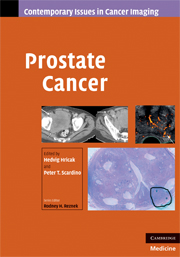Book contents
- Frontmatter
- Contents
- Contributors
- Series Foreword
- Preface
- 1 Anatomy of the prostate gland and surgical pathology of prostate cancer
- 2 The natural and treated history of prostate cancer
- 3 Current clinical issues in prostate cancer that can be addressed by imaging
- 4 Surgical treatment of prostate cancer
- 5 Radiation therapy
- 6 Systemic therapy
- 7 Transrectal ultrasound imaging of the prostate
- 8 Computed tomography imaging in patients with prostate cancer
- 9 Magnetic resonance imaging of prostate cancer
- 10 Magnetic resonance spectroscopic imaging and other emerging magnetic resonance techniques in prostate cancer
- 11 Nuclear medicine: diagnostic evaluation of metastatic disease
- 12 Imaging recurrent prostate cancer
- Index
- Plate section
- References
11 - Nuclear medicine: diagnostic evaluation of metastatic disease
Published online by Cambridge University Press: 23 December 2009
- Frontmatter
- Contents
- Contributors
- Series Foreword
- Preface
- 1 Anatomy of the prostate gland and surgical pathology of prostate cancer
- 2 The natural and treated history of prostate cancer
- 3 Current clinical issues in prostate cancer that can be addressed by imaging
- 4 Surgical treatment of prostate cancer
- 5 Radiation therapy
- 6 Systemic therapy
- 7 Transrectal ultrasound imaging of the prostate
- 8 Computed tomography imaging in patients with prostate cancer
- 9 Magnetic resonance imaging of prostate cancer
- 10 Magnetic resonance spectroscopic imaging and other emerging magnetic resonance techniques in prostate cancer
- 11 Nuclear medicine: diagnostic evaluation of metastatic disease
- 12 Imaging recurrent prostate cancer
- Index
- Plate section
- References
Summary
Introduction
Nuclear medicine is a highly sensitive technique for detecting metastatic disease at sites throughout the body using radiotracers as biomarkers of cancer biology. Radioactive signals from these radiotracers are detected by sophisticated radioactivity-detector imaging systems including single-photon-emission computerized tomography (SPECT) and positron-emission tomography (PET). In this way nuclear medicine imaging is an example of “functional” or “molecular imaging” in which the imaging itself is based on a biochemical or physiologic property of the imaged tissue. For the patient with prostate cancer, nuclear medicine techniques, when used judiciously, are an important part of optimized cancer care; for example, bone scans are very commonly used to detect and follow up skeletal metastatic disease.
The clinical states model of Scher and Heller provides a useful guide to the possible progression of prostate cancer from a localized disease to widely spread tumor [1,2, 3] (Figure 11.1).
From the standpoint of natural history and chance of progression in the individual patient, prostate cancer is one of the most variable of all tumors. The cancer itself may behave in a highly indolent matter and be localized in the prostate gland for years, with the patient's death being due to other diseases. Then again, a localized tumor may rapidly progress, become widely metastatic within a short time and lead to death.
Fortunately, clinical trials are now resolving key management questions based on objective features of cancer histology and biochemistry.
- Type
- Chapter
- Information
- Prostate Cancer , pp. 177 - 194Publisher: Cambridge University PressPrint publication year: 2008



